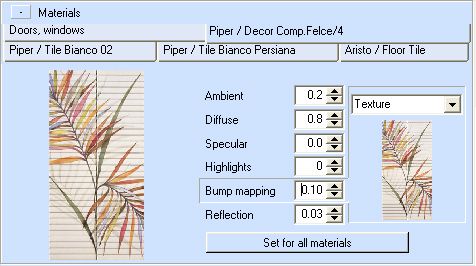27.4. This panel contains a list of materials (tiles, wallpapers, etc.) that are used in the project. This panel is used to adjust light settings of materials:

![]() /
/![]() button before the name of the panel allows you to hide or show the panel.
button before the name of the panel allows you to hide or show the panel.
‘Ambient’ – is a reflected background light radiation of material which is so distributed by the environment (objects, walls, etc.) that it is impossible to define it. In the simplified calculation model (without calculation of reflected light - radiosity) it is necessary to set ambient, otherwise objects will be to dark. The default ambient for all objects is 0.6. Adjusted range: from 0 to 2. If radiosity is turned on, ambient is automatically set to 0.2.
‘Diffuse’ – is a reflection of the light coming from one direction, which is the same in all directions. Diffuse is the basic component, while calculating multiple light reflection (radiosity). The default ‘Diffuse’ for all objects is 0.6. Adjusted range: from 0 to 2. If radiosity is turned on, diffuse is automatically set to 0.8.
These two components (Ambient and Diffuse) could be adjusted after automatic setting, but in most cases default settings are sufficient. When you use only daylight, the light gets to the room through windows, and you should use radiosity, because without it the scene will be to dark. You can adjust the degree of illumination by increasing daylight brightness or by adjusting material diffuse of walls, floor and ceiling. By increasing ‘Diffuse’ of a material you will increase the degree of registration of the light from this material in the general scene illumination.
‘Specular’ - is a reflection of the light coming from one direction, in a certain direction. Shiny metal and plastic have a high specular component, while a piece of carpet doesn’t. This option defines how shiny material looks. The default specular value for all materials is 0. Adjusted range: from 0 to 2. . If you turn on gloss for a material, its 'Specular' value will be automatically set to 0.8.
‘Highlights’ – the size of glares that is determined by the quality of the surface. It could vary from 40 (plastic) to 250 (polished metal). The higher is the quality of the surface, the smaller and brighter are the glares. Adjusted range: from 0 to 400. If you turn on gloss for a coating, its 'Highlights' value will be automatically set to 60.
'Bump mapping' – bump mapping value in this field is entered automatically, if you activate bump mapping mode in your project. If you set bump mapping value higher than 0, you will be able to choose a bump map type. The default bump map type is 'Texture', i.e. material’s own texture is used to create a bump map. You can also choose another bump map types: 'Granite', 'Leopard',' Marble', 'Ripples' or 'Quilted'. After choosing a bum map type the corresponding image will appear under the bump map type checkbox. The higher is a bump mapping value, the higher will be the surface’s roughness. Bump mapping adjustment range: from 0 to 1. If you have chosen a 'Texture' type, the sufficient bump mapping value will be 0.1. Note that a bump mapping effect doesn’t actually modify the size or shape of the surface. It only simulates bumps and wrinkles on the surfaces of an object.
‘Reflection’ – the ability of material to reflect light only in that direction for which the angles of incidence and reflection are the same. The default reflection for all objects is 0. Adjusted range: from 0 to 1. You can create an ideal mirror by setting Ambient=0, Diffuse=0 and Reflection=1. The majority of polished surfaces will look realistic if their reflection is 0.03-0.15.
By clicking on ‘Doors, windows’ you can set light properties of doors/windows materials. Ambient and diffuse settings are used not only for doors and windows, but also for non-covered ceilings and grout. Therefore, when you reduce reflection properties of all coatings, these room units correspond to the common brightness of the image.
‘Set for all materials’ button allows you to set the given material characteristics for all materials.